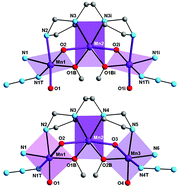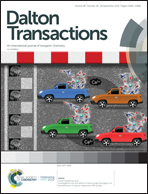The effect of the orientation of the Jahn–Teller distortion on the magnetic interactions of trinuclear mixed-valence Mn(ii)/Mn(iii) complexes†
Abstract
Two new trinuclear manganese complexes, [Mn3(L1)(μ-OCH3)2(N3)2]·CH3OH (1) and [Mn3(L2)(μ-OCH3)2(N3)2]·CH3OH (2), have been obtained from the reaction of Mn(OAc)2 4H2O, NaN3 and the preformed N6O4-donor H4L1 or H4L2 compartmental ligands, which are synthesized via Schiff base condensation of pentaethylenehexamine with 2-hydroxybenzaldehyde or 2-hydroxy-3-methoxybenzaldehye, respectively. Complexes 1 and 2 have been characterized by spectroscopic methods and single-crystal X-ray analysis. The structural studies indicate that both 1 and 2 are mixed-valence complexes containing angular Mn(III)–Mn(II)–Mn(III) cores in which the metal centers are connected to each other by phenoxido and methoxido bridging groups. The coordination environment around the manganese ions is analogous in both complexes, but for a change in the direction of the Jahn–Teller distortion around the external Mn(III) ions when going from 1 to 2, which is mainly attributed to the steric effect of different substituents on the phenyl rings of the ligands. The analysis of the magnetic susceptibility data indicates the presence of antiferromagnetic intramolecular coupling in both complexes, but the interaction in 1 was found to be nearly one order of magnitude weaker than that in 2. This fact is rationalized on the basis of the different orientation of the Jahn–Teller distortion, which modifies the magnetic exchange pathway through the phenoxido bridges from the equatorial–axial connection type observed in 1 to the axial–axial linkages displayed by 2.



 Please wait while we load your content...
Please wait while we load your content...